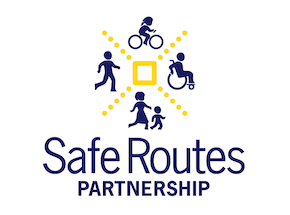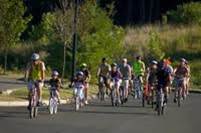
Resource Library
Page 92 of 107 pages. This page shows results 1821 - 1840 of 2139 total results.
Fact Sheet
This website provides a list of different audits for various settings and environmental attributes. The general purpose of an audit is to identify concerns for pedestrians and bicyclists related to the safety, access, comfort, and convenience of the environment.
Report
2012 Benchmarking Report
As the project progresses, it will offer more precise benchmarks and recommendations for advocates and government officials so that they have the data they need to improve bicycling and walking in the United States and eventually all of North America.
 The Wake County Child Safety Action Network (WakePedNet)is a varied group of individuals who share a similar goal: to raise awareness of child pedestrian injury concerns in Wake County, North Carolina to share and plan activities, and to build greater capacity to prevent pedestrian crashes and injuries.
The Wake County Child Safety Action Network (WakePedNet)is a varied group of individuals who share a similar goal: to raise awareness of child pedestrian injury concerns in Wake County, North Carolina to share and plan activities, and to build greater capacity to prevent pedestrian crashes and injuries.
 In an effort to continue the momentum from her Let’s Move! campaign, First Lady, Michelle Obama and television star Rachel Ray visited Mississippi on February 27, 2013. Mississippi was all too proud to be a part of the third anniversary of this movement and even happier to report progress over the past three years.
In an effort to continue the momentum from her Let’s Move! campaign, First Lady, Michelle Obama and television star Rachel Ray visited Mississippi on February 27, 2013. Mississippi was all too proud to be a part of the third anniversary of this movement and even happier to report progress over the past three years.
Webinar
Opportunities for Communities in the Wake of MAP-21
These PowerPoint slides summarize MAP-21, its impact on transportation funding, and opportunities for supporting walking/biking projects.
 At the National Bike Summit this year, Douglas Meyer from Bernuth & Williamson presented some fascinating results about what Congressional allies and opponents think about bicycling.
At the National Bike Summit this year, Douglas Meyer from Bernuth & Williamson presented some fascinating results about what Congressional allies and opponents think about bicycling.
Model Policy
School districts that adopt school bicycling or walking policies ensure that transportation safety rules for the district are consistent and standardized. Policies developed at this jurisdictional level can also help lay the groundwork for better and safer behaviors. This document provides a model school walking policy.
 Spring brings a new season for the State Network Project in New Jersey. As you have likely heard, I will be leaving the Safe Routes Partnership this month. But like I welcome the warmer and longer days, I also look forward to new opportunities and stronger partnerships. I am moving onto a program at Montclair State University that still has ties to the SRTS movement.
Spring brings a new season for the State Network Project in New Jersey. As you have likely heard, I will be leaving the Safe Routes Partnership this month. But like I welcome the warmer and longer days, I also look forward to new opportunities and stronger partnerships. I am moving onto a program at Montclair State University that still has ties to the SRTS movement.
Toolkit, Report, Case Study
A School Leader's Guide to Collaboration and Community Engagement
According to CSBA’s research with school governance teams in California, schoolboard members recognize the link between student health and academicachievement, but when faced with a multitude of competing priorities and limitedresources, are hard pressed to make wellness a high priority in the district/COE.
 Last week, the Southern California Association of Governments (SCAG) convened the annual Regional Conference and General Assembly (GA) in Palm Desert for two days. The GA is a yearly convening of elected officials from across Southern California to celebrate the accomplishments of the past year.
Last week, the Southern California Association of Governments (SCAG) convened the annual Regional Conference and General Assembly (GA) in Palm Desert for two days. The GA is a yearly convening of elected officials from across Southern California to celebrate the accomplishments of the past year.
 A new study from U.S. PIRG and the Frontier Group shows that after decades of steady growth, U.S. driving rates have slowed, and even stalled – and that in the long term, Americans are unlikely to return to driving as much as they did before.
A new study from U.S. PIRG and the Frontier Group shows that after decades of steady growth, U.S. driving rates have slowed, and even stalled – and that in the long term, Americans are unlikely to return to driving as much as they did before.
Report, Case Study
State Networks Create Policy Changes
The Safe Routes Partnership is implementing the State Network Project to ensure program success and leverage resources by creating SRTS State Networks in nine states and the District of Columbia. The following report outlines how State Networks can create policy change.

Webinar
Addressing Liability Concerns Related to Walking School Buses, Bike Trains, Remote Drop-Off and More
This webinar from January 16, 2014 discusses basic liability concepts and then delves into issues related to walking school buses, remote drop offs and bike trains.
 It’s hard to believe that it has been more than a year since Congress passed the transportation bill, MAP-21, which consolidated Safe Routes to School into the Transportation Alternatives program (TAP).
It’s hard to believe that it has been more than a year since Congress passed the transportation bill, MAP-21, which consolidated Safe Routes to School into the Transportation Alternatives program (TAP).
Fact Sheet
The new transportation law, MAP-21, gives Metropolitan Planning Organizations (MPOs) moreresponsibility for distributing federal transportation funds. MPOs serving areas with more than200,000 residents are required to run a competitive grant program to distribute federal funds fromthe Transportation Alternatives (TA) program.
Journal Article, Report, Research
Impact of the Walking School Bus Program on Children's Pedestrian Safety Behaviors
A March 2012 research brief by Active Living Research, Impact of the Walking School Bus Program on Children’s Pedestrian Safety Behaviors, reported that parents listed their children’s safety as one of the top concerns regarding walking to school, and that improving safety may lead more parents to allow their children to walk to school.



